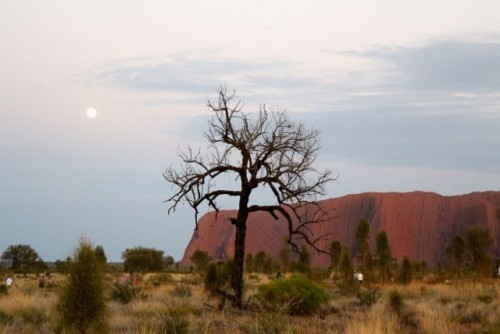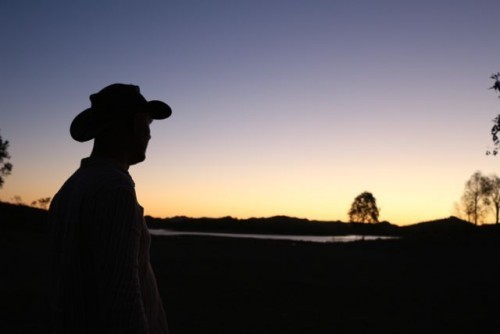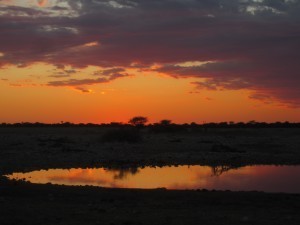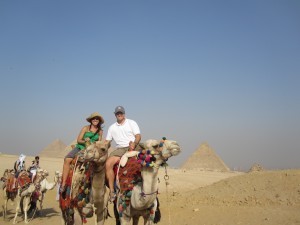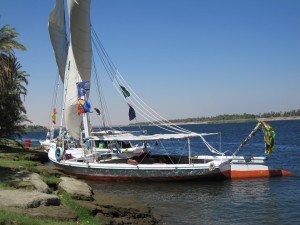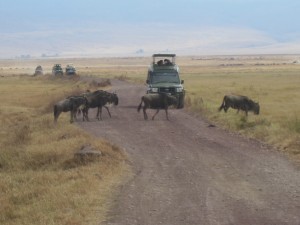Rolf Potts's Blog, page 24
October 23, 2014
Morning Rituals
Vagablogging :: Rolf Potts Vagabonding Blog

(morning rituals – photo credit: icultist on Flickr)
The fluidity of travel is a double-edged blade. It’s one of the things I love most about it – that each day is different and you don’t know what to expect. It pulls you into the present, encouraging you to pay attention to everything going on around you, rather than going into auto-pilot mode.
We are beings of habit, though. Our brains are wired to develop patterns of behavior, so that we’re not constantly making decisions. It uses less energy and frees up our mental resources. So when I’m traveling for extended periods of time, I begin to miss the structured days, the habits, the rituals. I do take some of these with me on the road, just to make my life a little bit easier. For instance, I usually travel with protein powder and oatmeal, so that I can have a consistent meal to start off the day. It gives me a bit of respite – being able to wake up and not having to worry about what I’m going to eat for breakfast. Get centered into the day before I have to start make decisions. Then, after that – I take the day as it comes.
I also take a kettlebell around with me when I’m able. (Which usually means whenever I’m not traveling by plane.) Yes, I even carried one along for the 8,000 mile motorcycle trek that I took earlier this year. It was 25lbs of extra weight, but then I was also packing my podcast equipment – so I wasn’t traveling light. What I love about the kettlebell is that it’s versitile and allows me to keep fit when I’m on the road. Sure, there are a lot of body-weight exercises I could do, but just having that weight there with me is an extra bit of motivation. I can’t ignore it. Hell, if I’m going to lug it around, I *have* to put it to use.
While I’m traveling – that’s about all the ritual that I take with me. When I get home, though, I have deeper morning rituals that help me get the most out of the day. When I first get up, I take care of meditation, gratitude and meals. Meditation and gratitude are part of centering myself and taking a moment to recognize the things I should be grateful for. For meditation I’ve been testing out Headspace (an app) and for gratitude I’ve used the 5-minute Journal for over a year. After that I prepare my meals for the day (unless I’m going out). Admittedly, I’m a utilitarian eater – so I just don’t want to have to worry about those decisions when I’m hungry. I’ve also found that taking care of it at once means that I eat healthier, rather than just grabbing whatever is available.
I’ve been trying out a new framework for productivity and happiness each day. The morning ritual is a part, but only the first step. I’m going to stick with it for a few more weeks to see how it works out. If I find it useful, I’ll share.
So, out of curiosity, what morning rituals do you have?
–
Chris Plough writes and podcasts at oznog.com, where he shares stories and advice from his adventures and from the incredible people that he’s met along the way. You can also follow him on twitter: @chrisplough.
Original article can be found here: Morning Rituals
October 22, 2014
Why you should be reminded about “mistake-fares”
Vagablogging :: Rolf Potts Vagabonding Blog
Everyone’s had those days where they’re day-dreaming about a trip they can’t afford and they just wish to themselves that flight prices would magically drop and they could magically afford that trip to Milan, Italy or Kenya or wherever.
Well…I can’t tell you that magic is happening but I have honestly booked flights to Milan, Italy and Nairobi, Kenya for $300 or less each, roundtrip.
If you’re asking yourself, “Is this some kind of joke? Is this a mistake?” then the answer is…well…one of those things is true.
I know I’ve blogged about this before, but you seriously need to be reminded about this. Because mistake fares are exactly the kinds of deals you daydream about.
What is a mistake fare?
Most basically, a mistake fare is any time there’s some kind of mistake in the process of pricing a ticket (or hotel room) online. Most often, this happens because there’s some kind of error in the process of programming that price. For instance, whoever is plugging in the formula for that price somehow misses plugging in the fuel portion of that price.
How cheap can these mistake-fares get?
These mistake-fares are all over the place in terms of price. We don’t tend to pay attention to them until their as low as $400 or less for an international ticket. Once there was even a “$0″ United fare that cost only $5 in airport taxes, but it wasn’t honored.
Which brings me to another important point…
Do these mistake-fares actually get honored?
The airline mistake fares almost always get honored. The $0 United example didn’t get honored because no one actually bought anything. But for the most part a mistake fare is going to be cheap enough to be a ridiculously good deal, but cost you enough for the airlines to make the decision to honor it.
For whatever reason, hotel mistake-fares on the other hand are not always honored. In this case, the hotel will generally reach out to contact you and inform you of the mistake and offer the chance to cancel.
How do you find these mistake-fares?
There is only a little bit of “finding” involved in mistake-fares. For the most part, the best way to “find” mistake-fares is by connecting with other “travel-hackers” who might publish these mistake-fares on their social media. For instance, my husband and I try to share the mistake-fares we hear of on our Facebook page. Because this network of people is so big, and thanks to the forum “Flyertalk”, the word tends to spread.
However, like I said, there is still some “finding” involved.
Here’s what I mean. Because this pricing mistake is usually an error in how the price was code, it can take some trial and error to figure out what the mistake actually is.
For instance one person may be browsing “fill-in-the-blank-bookingservice.com” and stumble upon a ticket to Milan in February for only $150 roundtrip. The error is existing on fill-in-the-blank-bookingservice.com, so you’ll know right away that you need to be booking your ticket there. But maybe you aren’t free in February, so you try out June. No luck. Or maybe you’re not interested in Milan so you try Rome. No luck.
Many times these mistake-fares are somewhat specific and restrictive, but maybe less than you’d think.
In the example I just used with Milan, there were some people booking in other times of the year, but not all times of the year were revealing the mistaken price. Or, in the case of the Nairobi mistake-fare mentioned, some people were finding that mistaken price for other destinations, but not all destinations.
Finding the mistake-fare you want can take some playing around, but be careful. They don’t last long.
These mistake-fares are such a fine line between amazing and inconvenient, because not only do they tend to be specific, but they go quickly. So sometimes in the time it takes you to find out if you can get the vacation time off, or in the time it takes you to call up a travel-buddy, the mistake gets fixed and it’s gone.
Because of this, figure out the cancellation policy right away. If the cancellation policy allows any decision-making time at all, then you can feel free to book a mistake-fare speculatively. Which is to say, you can book the first mistake-fare that catches your attention as possibly feasible, without worrying about working out the details ahead of time.
If there is any flexibility of cancellation at all, book first and work it out later.
Who are mistake-fares good for?
While this may sound complicated, it is perfect for anyone with a free spirit and a spontaneous nature. Or, for people who want to see the whole world. If you have one specific destination in mind for your next trip, and are uninterested in other destinations, then mistake-fares are not for you. But if you are always up for an adventure, and curious about travel of all kinds, then you may just find a mistake-fare fitting your next spontaneous travel needs.
Original article can be found here: Why you should be reminded about “mistake-fares”
October 21, 2014
Vagabonding Field Report: Magnetic Island and Barbie Cars
Vagablogging :: Rolf Potts Vagabonding Blog
Cost/day
There are 2 significant expenses with Magnetic Island. The first is the ferry that takes you to the island which is $32 for an adult. The second is just as much a necessity as it is a luxury and that is the Mokes. For around $80 you can hire one of these miniature petrol cars to take you around the must see island. Food can be pricy also, but a picnic could see you through the day.
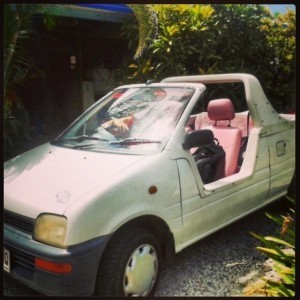
Describe a typical day
We boarded the passenger ferry in Townsville, a smooth but breezy cold ride took us to Magnetic Island. We first stocked up on water and sun cream at the local IGA supermarket. Then we made our way to hire a moke. Parting with $80 we had picked up the keys to our new ride. The car was nothing more than an oversized Barbie car. Pink and white and just enough room for the two of us. So we took off on a tour of the island. Magnetic Island is scenically beautifully.
We pulled our car up at several look outs. The luscious green foliage stretched down the rolling hills into the sea. Each point we took in was a pleasure and a treat for the eyes. We watched the wildlife of exotic bird and marsupials fluttering. hopping. crawling out of the many bushes and trees that stretched the steep roads.
Soon it was time to park the car on the shore line and start walking one of the many walking tracks that weave around the Island. We removed out shoes and dipped our feet in the sea. Boulders lay at the bottom of the cliff face immersed in water. Here is where a keen eye could spot much of the islands aquatic wildlife amongst the cracks and crevices. The track was beautiful and secluded. We were aloud our own private peace as we looked out to sea watching the wave’s crash against the shore
. 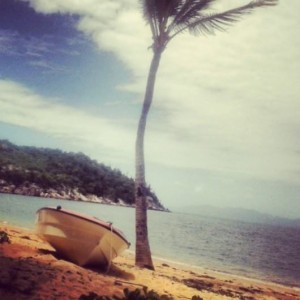
Our stomachs grumbled to let us know it was time for lunch. After a quick read of a local pamphlet that spelled out where to eat we decided to settle for a Mexican feed. With directions in hand and a small road map it still took us almost 45 mins to find the eatery. This however was wasted 45 minutes, the restaurant looked like a dilapidated unkempt old shack that was in dire need of a bulldozer. We imagined a buffet at a wake would have better ambience. So we gave up on Mexican and headed back to the dock to eat at Peppers. We sat on the veranda and took in the view. A rather over enthusiastic waitress took our orders and we sat and drank lemonade whilst talking over the mornings highlights. The food was great but with a substantial price tag to suit. I tucked into an Angus burger and chips with all the bacon and cheese I could want. My mouth is watering just at the thought of just how beautiful that meal was.
After lunch we decided it was time to relax on the beach so with a few essentials in hand we made our way to Magnetic Island’s paradise beach on Nelly Bay. We led out on the beautiful golden sands and took an occasional swim in the sea. It was quiet but we shared the beach with a couple of family’s holiday making. Before long it came time to hand back our miniature motors and climb aboard the ferry. A downside to Magnetic Island is the first and last ferry don’t run early or late enough, as this was a day trip we had to abide by those times. So we set off back across the water and back to Townsville for the night.
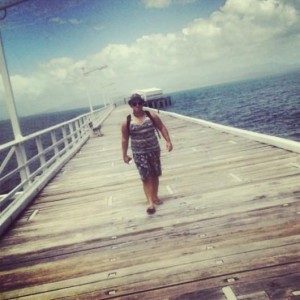
De scribe an inter esting conversation you had:
There wasn’t really a chance to get to talk to the locals but along the way we did pick up some interesting information. Magnetic Island got its name from exactly that a Magnetic force, which probably doesn’t come as a big surprise. The interesting element is that it was the only island around the area and further down the coast that would put the old ships off course as it would interfere with the ships compasses, and hence the reason it took the name Magnetic Island.
What did you like? Dislike?
I loved the Island and there is a great element of fun in driving the mokes around to explore. My dislike is the ferry times, they no doubt accommodate for the 9-5 workers who work on or off the island, and it felt we couldn’t cram in enough in such a short span of time. The island has so much more to explore and provides a huge amount of entertainment all year round. Next time around I think I would book in to stay at a hotel and give more time to exploring more of the beautiful island
Where Next? Robe!!!!!
Original article can be found here: Vagabonding Field Report: Magnetic Island and Barbie Cars
Australia’s Red Center: The beautiful nothing
Vagablogging :: Rolf Potts Vagabonding Blog
There’s nothing in the red center of Australia.
If by nothing you mean echos of endless wide spaces and wide sky that holds the world together like an eternal ribbon of Australian blue around a package of rainbow colours that can only be unwrapped slowly.
Beneath the thin veneer of “nothing” are layers of something stunningly, historically, culturally, naturally, creatively beautiful.
The earth is simultaneously desert-hard and sand-silt soft, as if the entire surface was sifted through a flour sieve.
“Red” is not the right word. I’m not sure there is a right word. The soil is a particular shade of burnt sienna that Crayola never thought of.
“Green” runs the gamut from dusty sage, almost grey, through every subtlety of Mediterranean olive, to garish lime. There is plant life everywhere, even where it seems there is not.
Where there are trees, they are black and gnarled; an aboriginal crone’s hand reaching out of the parched soil, grasping desperately at the sky, begging for water.
There’s nothing in the red center of Australia
Except life in unexpected places:
Lizards, big and small. Under rocks, in the shade, waddling awkwardly through the camp kitchen, picking at scraps.
Great big, tick shaped beetles, huddled beneath pieces of curling bark on the trunk of a tree.
Snakes (even though I don’t like them)
Enormous, Wedge-tailed eagles whirling overhead, crouched over road-kill-a-roos, perched majestically on bare branches.
Dusty children perched on piles of old rubber tires on turn offs to dirt roads leading nowhere.
Flies; god, the flies.
Wildflowers, in white and yellow, the tiniest things, blooming in a blooming desert! Against all odds, laughing at the sun.
Heat is a living thing, dancing in an iridescent ball gown to music only she can hear.
There is nothing in the red center of Australia.
Except the beating heart of a continent:
Dirt the colour of dried blood.
A rock, like an enormous, petrified heart jutting out of the earth.
I can hear the heartbeat, if I stand still, in the pounding of my own blood at my temples, agitated by the incredible heat, the searing sun, the blinding reflections.
At night, the “nothing” sings.
Insect songs, celebrating relief from another day’s heat.
Star songs, sung for thousands of years over sleeping souls by watchful guardians.
The drumbeat of the darkness.
The long, low hum of the moon; perhaps it’s echo inspired the didgeridoo.
The grass whispers behind the melody, wind through long, feathery reeds.
It’s a lullaby.
There’s nothing in the red center of Australia.
Unless you take the time to look.
Original article can be found here: Australia’s Red Center: The beautiful nothing
October 19, 2014
Travel writing is about what the place brings out of the writer
Vagablogging :: Rolf Potts Vagabonding Blog
“What raises travel writing to literature is not what the writer brings to a place, but what a place brings out of the writer.”
–William Zinsser, in They Went: The Art and Craft of Travel Writing (1991)
(1991)
Original article can be found here: Travel writing is about what the place brings out of the writer
October 17, 2014
How Africa got in my soul (and stayed there)
Vagablogging :: Rolf Potts Vagabonding Blog
“We need HOW many shots?” Six immunizations, a signed yellow fever card and two prescriptions later we left the doctor’s office. It was going to be worth it, we just knew it! Five years and a few extra booster shots later and we were right. Our time on the African continent yields some of my most favourite travel memories and life-changing experiences. “Africa gets into your soul and stays there”. This is my answer to most questions about my time in Africa. With a smile, I remember the moments that would not have been possible anywhere else. If you’re even a bit curious-Go, you’ll never be the same again.
We’ve traveled to Africa three times and each has been more different than the time before it. There was Egypt in the north, South Africa and its surrounds in the south and Tanzania and Kenya in the east.
Egypt is filled with history, culture, religion and life on the Nile. We slept on a felucca, rode camels in the Sahara, translated hieroglyphics, awed at the pyramids and sphinx and ate our weight in falafel. Egypt’s appeal was the intertwining of religion and life amidst an ever-changing landscape. It seemed that there’s a part of Egypt ruled by the river and a separate part away from it all. Markets clamored with vendors selling their wares and religion was heard all around – most especially as the sound of the muezzin floated through the air calling worshippers to prayer. Perfumes, hookah pipes, cartouches and papyrus were readily sold to travelers as take home items and history was captured on cave walls.
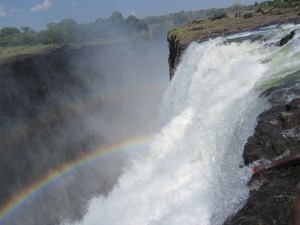 Southern and western Africa is still my favourite of parts we’ve visited so far. We spent three weeks through parts of South Africa, Namibia, Botswana, Zambia and Zimbabwe. Hanging with penguins at Boulder Beach, glimpsing the southernmost tip and feeling like the true king of the world atop Table Mountain are special. Bush camping in the Okavango Delta was more than memorable since a raging hippo chased our mokorros and we lived to tell the tale. And let’s not even talk about the jump into Devil’s Pool-this is truly the definition of living on the edge! My favourite beyond a shadow of a doubt was Namibia. Etosha National Park’s watering hole is Discovery Channel in living colour as silent onlookers sit for hours waiting for animals to visit for a drink. Soussevlei is a sand lover’s paradise and hiking Dune 45’s bright, brilliant sand dunes make you feel like a cherry seated atop nature’s sundae. After visiting Namibia, it’s become one of my most treasured memories.
Southern and western Africa is still my favourite of parts we’ve visited so far. We spent three weeks through parts of South Africa, Namibia, Botswana, Zambia and Zimbabwe. Hanging with penguins at Boulder Beach, glimpsing the southernmost tip and feeling like the true king of the world atop Table Mountain are special. Bush camping in the Okavango Delta was more than memorable since a raging hippo chased our mokorros and we lived to tell the tale. And let’s not even talk about the jump into Devil’s Pool-this is truly the definition of living on the edge! My favourite beyond a shadow of a doubt was Namibia. Etosha National Park’s watering hole is Discovery Channel in living colour as silent onlookers sit for hours waiting for animals to visit for a drink. Soussevlei is a sand lover’s paradise and hiking Dune 45’s bright, brilliant sand dunes make you feel like a cherry seated atop nature’s sundae. After visiting Namibia, it’s become one of my most treasured memories.
And then there’s the Serengeti and Ngorongoro Crater. Masai warriors live their lives off of the land and teach their children to do the same. Dotted through the plains you see Masai houses and schools left standing for the next group to come through as the nomads move to a new location. Dry season floods the view in colours of beige, red, brown, orange and yellow showing the effects of nature on the landscape. Pockets of bright green pop where rivers flow with life in the wet season. Dust mixed with gravel and the omnipresent red dirt kicks up as the 4x4s journey the open roads in search of sightings. As trucks pass on the narrow lanes camera lenses and binoculars pass each other as their owners pop the tops of trucks to feel the wind and come face to face with a neighboring giraffe.
Africa is different. Africa is beautiful. Africa is a blending of thousands of cultures amidst a backdrop of animals and a landscape controlled by nature. Africa leaves you wanting to return and teaches lessons you may not have known you needed to learn. Africa gets into your soul and stays there.
For more of Stacey’s travel musings check out her website.
Original article can be found here: How Africa got in my soul (and stayed there)
How Africa got in my soul…..and stayed there!
Vagablogging :: Rolf Potts Vagabonding Blog
“We need HOW many shots?” Six immunizations, a signed yellow fever card and two prescriptions later we left the doctor’s office. It was going to be worth it, we just knew it! Five years and a few extra booster shots later and we were right. Our time on the African continent yields some of my most favourite travel memories and life-changing experiences. “Africa gets into your soul and stays there”. This is my answer to most questions about my time in Africa. With a smile, I remember the moments that would not have been possible anywhere else. If you’re even a bit curious-Go, you’ll never be the same again.
We’ve traveled to Africa three times and each has been more different than the time before it. There was Egypt in the north, South Africa and its surrounds in the south and Tanzania and Kenya in the east. The cultures, climates, and customs are all different and the experience in each everlasting. For some reason, I always wanted to visit Africa. I can’t tell you exactly why, but I couldn’t wait to get there and still can’t wait to return. In our travels, people have been real, scenery epic, food delectable and connections priceless. It feels like Billy Crystal’s search for that ‘one thing’ in City Slickers. I’m not sure I can put my finger on it exactly, but something about the continent is mystical and when you find it you just know. It has a magic all its own.
Egypt is filled with history, culture, religion and life on the Nile. We slept on a felucca, rode camels in the Sahara, translated hieroglyphics, awed at the pyramids and sphinx and ate our weight in falafel. Egypt’s appeal was the intertwining of religion and life amidst an ever-changing landscape. It seemed that there’s a part of Egypt ruled by the river and a separate part away from it all. Markets clamored with vendors selling their wares and religion was heard all around – most especially as the sound of the muezzin floated through the air calling worshippers to prayer. Perfumes, hookah pipes, cartouches and papyrus were readily sold to travelers as take home items and history was captured on cave walls. It’s a place where fresh vegetables are unavailable to travelers and culture is omnipresent. Standing at the foot of the Great Pyramids with sand as far as the eye can see-that is something only capable in Egypt.
 Southern and western Africa is still my favourite of parts we’ve visited so far. We spent three weeks through parts of South Africa, Namibia, Botswana, Zambia and Zimbabwe. There’s not enough paper or word count for a full explanation of the merits of each of these beautiful places. The history of Robben Island and Soweto are captured in faces, videos, images and stories. Hanging with penguins at Boulder Beach, glimpsing the southernmost tip and feeling like the true king of the world atop Table Mountain are special. Bush camping in the Okavango Delta was more than memorable since a raging hippo chased our mokorros and we lived to tell the tale. Victoria Falls is worthy of every adjective ever written about her, each side providing views more enchanting than the next. And let’s not even talk about the jump into Devil’s Pool-this is truly the definition of living on the edge! My favourite beyond a shadow of a doubt was Namibia. Who knew? Before I journeyed to Africa, Namibia was a place that had dunes that went on forever and a fan in Angelina Jolie. Then everything changed. Etosha National Park’s watering hole is Discovery Channel in living colour as silent onlookers sit for hours waiting for animals to visit for a drink. Soussevlei is a sand lover’s paradise and hiking Dune 45’s bright, brilliant sand dunes make you feel like a cherry seated atop nature’s sundae. After visiting Namibia, it’s become one of my most treasured memories and a place that I talk about with only smiles and wide eyes.
Southern and western Africa is still my favourite of parts we’ve visited so far. We spent three weeks through parts of South Africa, Namibia, Botswana, Zambia and Zimbabwe. There’s not enough paper or word count for a full explanation of the merits of each of these beautiful places. The history of Robben Island and Soweto are captured in faces, videos, images and stories. Hanging with penguins at Boulder Beach, glimpsing the southernmost tip and feeling like the true king of the world atop Table Mountain are special. Bush camping in the Okavango Delta was more than memorable since a raging hippo chased our mokorros and we lived to tell the tale. Victoria Falls is worthy of every adjective ever written about her, each side providing views more enchanting than the next. And let’s not even talk about the jump into Devil’s Pool-this is truly the definition of living on the edge! My favourite beyond a shadow of a doubt was Namibia. Who knew? Before I journeyed to Africa, Namibia was a place that had dunes that went on forever and a fan in Angelina Jolie. Then everything changed. Etosha National Park’s watering hole is Discovery Channel in living colour as silent onlookers sit for hours waiting for animals to visit for a drink. Soussevlei is a sand lover’s paradise and hiking Dune 45’s bright, brilliant sand dunes make you feel like a cherry seated atop nature’s sundae. After visiting Namibia, it’s become one of my most treasured memories and a place that I talk about with only smiles and wide eyes.
And then there’s the Serengeti and Ngorongoro Crater. These are places where tribal cultures roam, animals lead and visitors watch in awe of the surroundings as nature reigns supreme. Masai warriors live their lives off of the land and teach their children to do the same. Dotted through the plains you see Masai houses and schools left standing for the next group to come through as the nomads move to a new location. Dry season floods the view in colours of beige, red, brown, orange and yellow showing the effects of nature on the landscape. Pockets of bright green pop where rivers flow with life in the wet season. Dust mixed with gravel and the omnipresent red dirt kicks up as the 4x4s journey the open roads in search of sightings. As trucks pass on the narrow lanes camera lenses and binoculars pass each other as their owners pop the tops of trucks to feel the wind and come face to face with a neighboring giraffe. Magical might not even be the appropriate word.
There’s a sort of mysticism about Africa that transcends travel. Everyone we came in contact with welcomed us with open arms. The scenery enveloped travelers and the animals delight while going about their everyday existence. As we’ve discovered through our travels, if you want things to be the same as they are at ‘your house’ it’s better to stay home. Africa is different. Africa is beautiful. Africa is a blending of thousands of cultures amidst a backdrop of animals and a landscape controlled by nature. Africa leaves you wanting to return and teaches lessons you may not have known you needed to learn. Africa gets into your soul and stays there. Don’t believe me? Go!
For more of Stacey’s travel musings check out her website.
Original article can be found here: How Africa got in my soul…..and stayed there!
October 16, 2014
Vagabonding Case Study: Dyanne Kruger
Vagablogging :: Rolf Potts Vagabonding Blog
Dyanne Kruger
Age: Uh, somewhere breathtakingly near the tender age of 7-oh!
Hometown: Seattle, but haven’t lived in the U.S. for several years
Quote: “This ain’t a dress rehearsal, folks!” (I also favor “I am not the same having seen the moon shine on the other side of the world.”)
How did you find out about Vagabonding, and how did you find it useful before and during the trip?
To be honest, I believe that I likely was born with a wanderlust gene – with precisely the curiosity and the intrepid spirit that Rolf’s definition of “vagabonding” champions. I agree that sadly, many today seem inhibited from such a free-spirited approach, but for me, it was always natural to travel with a completely open spirit and welcome the unpredictable serendipity that can only come when one strays off the well-trod path (simple to do, even in the most otherwise highly touristed places like Bali), drop one’s arbitrary fear of “different” (i.e. in strangers, new foods, foreign customs, etc.), and eagerly embrace the unknown. Indeed, I was pretty much living the vagabonding life 30 years before I read the book. But I did enjoy commiserating with a kindred spirit through its pages, and found it most useful in reaffirming my bull-headed belief that dragging a 5 yr. old and an 8 yr. old to ride chicken buses and camp on Mexican beaches in ’76 wasn’t utterly nuts, but rather “educational” and indeed simply “good parenting”. 
How long were you on the road?
Uh, I’ve pretty much been more or less “on the road” for the past near 40 years. Lived in France and Italy for a spell, then based in Seattle, I flitted to and fro Central America as a tour operator for 20+ years. More recently, homeless in Asia for 3 years, s-l-o-w traveling through a near dozen countries on that side of the globe.
Where did you go?
Though I honestly think it’s silly to “count countries”, I believe my tally hovers somewhere near 40 now, and have lived in 5 (France, Italy, Vietnam, Thailand, and presently in Ecuador).
What was your job or source of travel funding for this journey?
Ever on a shoestring (I honestly think such is a blessing for it requires one to travel low to the ground and invites far more authentic mingling with locals), I turned my back on a promising climb up the corporate career ladder, in favor of starting my own international tour company. Didn’t get rich, but supported myself quite comfortably with it for 20+ years. More recently, upon “retirement” with a pitifully small U.S. pension, I sold everything and bought a one way ticket to Vietnam to teach EFL. And though I don’t “need” to teach financially, I find that part-time teaching plugs me into the local community and gives me a focus in my travels.Though there’s of course trade-offs and sacrifices to most any life style one chooses (e.g. in exchange for a boatload of air tickets, I’ve always lived frugally, driven 15+ yr. old cars, talked on pre-paid phones, and rarely step foot in a Starbucks), the truth is – you can actually travel more cheaply than you can live in the U.S. of A. Depends on how and where you choose to travel of course (i.e. your budget will stretch much further the slower you travel, and opting to explore Asia, Africa, South and Central America vs. Australia, the U.S. or Europe). But… that said, there’s surely no need to wallow in $4 a night hostels, nor are most countries in the world out of reach of a shoestring traveler.In short – if a life of travel is your dream – there are a bazillion ways to do it no matter your age, your circumstance, nor your bank account. It’s just a matter of A. accepting the trade-offs/sacrifices, and B. “MIH” (Making it happen).
Did you work or volunteer on the road?
While I’ve done a bit of free-lance volunteer teaching in Asia, I honestly find that most organized volunteer options are a bit suspect (not to mention often have breathtaking price tags that you just KNOW isn’t reaching the folks most in need). Rather, I find that there’s plenty of opportunity to simply help folks ad hoc along the way when I see where I can contribute.
Of all the places you visited, which was your favorite?
I’ve honestly found much to like about every country I’ve been lucky enough to visit (and find that each is utterly unique). Vietnam is probably my favorite (and where I lived for 2 years) mainly because it’s still so blessedly untainted by tourism, and the people have a unique dignity and a friendliness that is truly genuine. Another favorite is Morocco – perhaps surprisingly as a solo lass. It seems I often hear backpackers (of both genders) bemoan the “pestering” and harassment there, but I found nothing but kindly people and a most extraordinary diversity (the flavor of the Mediterranean, the windswept shores of the Atlantic, the Atlas mountains, the vast red sands of the Sahara) all sprinkled about a most singularly exotic country. And oh that luscious haven of Chefchaouen, “The City of Blue” – perhaps my favorite corner of the globe!
Was there a place that was your least favorite, or most disappointing, or most challenging?
Not sure I can think of a country that proved “disappointing” – mainly because I try hard to enter a new foreign land with few, if any expectations. Which… actually reminds me of one of my pet peeves when travelers “compare” countries. Often after only but a few days in a new country, they’re already comparing the food, the people, et al of country X to country Y. So silly (not to mention arrogant) – much like comparing apples and… eggplants for heaven’s sake (not to mention lumping entire ancient cultures into a single soundbite).That and… I honestly feel strongly that I am utterly BLESSED to even be able to visit any given country, so.. why would I go to the trouble to single out a string of negatives when I could instead just be grateful to see and experience the sights and unique culture of that country at all?That said… I did find Mongolia somewhat more challenging than most – but only because I chose a particularly physically challenging way to explore it, including 2 weeks hoofing and trekking among the Khasak Eagle Hunters in the remote mountains of western Mongolia – sleeping in unheated gers, with no electricity nor even an outhouse for weeks on end. In short, even for a gap year youngster the going would be considered a tad rough. For a solo lass near 7-oh? Definitely challenging (though quick to add, among my most memorable travel experiences to date).
Which travel gear proved most useful? Least useful?
Well for starters, in the early days of my travels (back in the 70′s and 80′s) we of course didn’t have ANY of the technos that travelers enjoy today. No email, nor Facebook nor Twitter nor Skype to keep in touch with family and friends back home. And cameras were f.i.l.m. so you had to carry a boatload of film canisters and could only hope you captured a decent shot of that sloth in the crook of that tree at Monteverde – until you got back home to have the film developed.
That said, I do think that travel in those days was more organic and truly adventuresome. Being out of touch for weeks on end (with no TripAdvisor to steer you to the best – and thus likely heavily gringoized – restaurant, nor smartphone to pre-book your hostel reservation, etc.) made travel a good deal more unpredictable. And quite honestly, I find that it is precisely the “unpredictable” that often leads to my most memorable travel experiences. Then again, quick to add – I’m now just as much a “flashpacker” as the youngsters. I can’t even imagine being an expat without Skype to be able to keep in touch w/ family and friends. And books? As a voracious reader, don’t even get me started on my beloved Kindle. Seriously. I doubt I could have adapted to perpetual foreign travel for years on end without the digitals we have today. Least useful? Well first of all as I travel strictly “carry-on only”, rarely do I tuck ANYTHING into my backpack unless it’s proven essential. In my early days of backpacking through Africa, I once toted around a lightweight sleep sack (rumored to be essential in many hostels and recommended in the more dodgy guesthouses). But it turned out that I never needed it, else I guess I’m just not that fussy about my sleeps. So I tossed it out in Morocco (along with most all my clothes) in favor of filling my backpack instead with not one but TWO fabulous wool rugs.
What are the rewards of the vagabonding lifestyle?
Surprisingly, the best rewards of bouncing around the globe aren’t so much the thrills of gawking at the World’s icons (the Great Wall, Uluru in Australia, the temples at Angkor Wat, etc.) but rather…For me, as a solo female vagabond, it’s the confidence that my travels have instilled in me. Starting with baby-steps on my first solo international forays to “tame” regions like Western Europe and English-speaking countries like Belize, I’ve gradually embraced ever more challenging destinations until… Honestly, I now feel that you could drop me on another PLANET, and I would simply hit the ground running – find myself a place to stay, some grub, and swiftly make myself comfy no matter how exotic the land. Indeed, there’s a most precious feeling of confidence gained from repeatedly managing such challenges – that spills over into most any challenge that life may hand you. I’m also extremely grateful for the expanded world-view that traveling and especially living, in developing countries has instilled in me. First hand in-depth experience with other cultures, governments, education and health care systems, etc. can’t help but temper your views of those same entities in your own native land. And especially – witnessing how much less the vast majority of the Planet’s billions manage to live with. And even more remarkably, how they do it with stoic dignity and true joy. In short, my travels have blessed me with boundless personal growth and confidence, and molded me into a far more patient and compassionate citizen of the World.
What are the challenges and sacrifices of the vagabonding lifestyle?
Ah yes, “sacrifices” – I’m glad you brought that up. It seems so many pine to travel the world, yet… they often don’t realize that choosing a life of travel is just a matter of making hard “choices”. Few of us have a trust fund, and many are presently in circumstances that (allegedly) pose obstacles (such as kids, debt, etc.) to popping on a backpack and bouncing ’round the globe. Often, even without these (did I mention “alleged”?) obstacles, many folks don’t seem to understand that a life of travel, takes trade-offs in the instant gratification of $6 caramel macchiatos, the smartest clothes, latest techno-toys, newest car, weekly pedicures, etc. All “choices”. The point is – I firmly believe that if traveling is what you want, there’s absolutely nothing stopping you from doing it – except yourself. That said, I also well understand that a vagabonding lifestyle isn’t necessarily everybody’s cup of tea. Yes, there are drawbacks – mainly, the obvious unavoidable separation from loved ones and friends back home. Yes, it’s tough to miss your best friend’s wedding, or the birth of a new niece or nephew. But again, with the marvels of today’s technology, I honestly feel that in some ways I’m closer to my friends and family now, than when I was living in Seattle. Plus – I’ve met so many fine new friends on the trail – I now have a whole host of chums scattered all over the globe.
What lessons did you learn on the road?
See “rewards” above. Mostly lessons about myself. That I’m a lot tougher than I thought. Indeed, the ups and downs of my travels have proven that there is little that can shake me. That many of the “problems” we allege in our comfy lives back home, are but “1st world problems” and really quite silly. That there are far more truly challenging problems that hundreds of thousands cope with each and every day their entire lives. In short, traveling long-term has taught me to keep it all in perspective, and to be ever grateful for the privilege of the (utterly fluke) circumstance of my U.S. of A. birth.
How did your personal definition of “vagabonding” develop over the course of the trip?
If there’s one thing I’ve learned from my near four decades of travel, is that my preferred travel “style” is ever evolving. Though I’ve never really had the proverbial “bucket list” seemingly so popular with young travelers today, when I first began traveling of course, I was just happy to be going ANYWHERE, and was far more prone to racing around to all the “gottado” sights and ticking off multiple countries in a single foray from home. With more experience traveling the globe however, I became more discerning (crossing whole countries off my list and paring down (and loosening) my itineraries in favor of spending more time in fewer select corners of a given destination. And while I still enjoy moving from place to place for a few weeks within say Myanmar, my preferred travel pace now favors “slow” travel, settling into a given country for weeks or months on end, and using a single location as a base to further explore that country in depth, with month-long forays into neighboring lands.
If there was one thing you could have told yourself before the trip, what would it be?
That’s easy, I only wish I’d taken the leap to permanent vagabonding years sooner! While I’m grateful for the many amazing foreign lands that I’ve been able to visit, this Big Blue Dot that we all call “home” is just sooo vast, and so lusciously diverse, I only wish I had a couple more lifetimes to explore every last corner – nice and slowly.
Any advice or tips for someone hoping to embark on a similar adventure?
Advice? Let’s see…
LESS IS MORE. Both as a life philosophy and packing. Seriously. You would be amazed at how much joy you’ll find in the freedom of having less “stuff”. Not to mention, how little you can comfortably get by with for months on end traipsing about with but a single backpack.
SOLO ROCKS! Indeed, for all my fellow “single” comrades out there (male, but especially female): Jump on in, the water’s fine!Whatever you do, don’t put off your travels just because you don’t have someone to travel with. Though some may well favor traveling with a chum or better yet, a beloved main squeeze, personally, I passionately believe that traveling solo offers benefits that duos and groups can never know. When you travel with a partner (let alone a group), you tend to be perpetually engrossed in yammering to each other, and thus – the locals will view you as closed off, with no need of their help nor friendship. You will be just another tourist, to be fleeced at worst, or ignored at best.Ah but as a solo – if you’re the least bit open and smiling, local folks will break their necks to offer assistance and kindness. You’ll be offered countless precious opportunities for sharing a mint tea in Morocco, dinner with a local family in Indonesia, or a place to lay your head in a ger in Mongolia.Rest assured too that “solo” doesn’t at all equate with “lonely”. Personally I’m an introvert, so have little need of constant socializing. But even extroverts will find plenty of company along the solo travelin’ trail. Hostels are hotbeds for connecting with a new pal or three to share expenses for a tour or some such. And I often meet fellow solos on buses, etc. that I hook up with for a few days to see the sights of a new locale. In short, I have never lacked for companionship no matter where I’ve roamed. And I much prefer solo, rather than having to continually compromise on itinerary, budget, pace, etc. for a longer term trip.
And lastly, among my favorite pearls of wisdom: “The best time to plant a tree was 20 years ago. The second best time is now.”Which nicely sums up my own mantra for following your dreams (be they travel or otherwise): “This surely ain’t a dress rehearsal, folks”. Along with: You’re never too old to pop on a backpack and skip ’round the globe, you’ll never have all the answers you need to take the leap, and you’ll never have a better time to do it than today. And indeed – none of us knows for sure if we even HAVE a “tomorrow”, so what are you waiting for???
When and where do you think you’ll take your next long-term journey?
Presently I’m catching my breath (literally, at 8,000 feet!) here in my new “home” in Cuenca, Ecuador. I traveled pretty hard and loose in Asia for the past three years, and I’m enjoying settling in here amid the cobbled streets and majestic cathedrals. But of course, I know myself all too well. It won’t be long (3 months? 6 months, tops) til I get the “itch” again. For there’s surely wanderlust running through my veins. And I look forward to slowly exploring this whole new (for me) continent – first the Galapagos of course, and now that I’m so close, I’ve got Cuba on my radar. Then there’s Machu Picchu , Columbia, Brazil, Chili, Argentina, shoot – maybe even Patagonia and Antarctica!
Read more about Dyanne on her blog, TravelnLass , or follow him on Facebook and Twitter.
Website: TravelnLass
Twitter: @travelnlass
Are you a Vagabonding reader planning, in the middle of, or returning from a journey? Would you like your travel blog or website to be featured on Vagabonding Case Studies? If so, drop us a line at casestudies@vagabonding.net and tell us a little about yourself.
Original article can be found here: Vagabonding Case Study: Dyanne Kruger
October 15, 2014
Long-term travel, consumerism, and purging
Vagablogging :: Rolf Potts Vagabonding Blog
Long- term travelers of all kinds will tell you that one of the most important preliminary steps to taking off is The Purge. That period of time that you devote to deciding which material possessions will still be necessary and dear to your heart after traipsing all over the globe in pursuit of clarity, freedom, connection, adventure, and knowledge. Clothing is donated, items are sold to pay for gear, and maybe a tupperware or two are packed to the brim with things you can’t bare to say goodbye to just yet. Everything else, everything that will represent your existence for the time you spend abroad will be packed into a backpack or suitcase, a necessary piece of gear that looked far bigger before you started packing it.
The act of purging everything was a huge undertaking that occupied our minds and our time for months before we left. The fact that we decided to get rid of almost everything helped in that we didn’t have to think much, we just had to get rid of it. Easier said than done.
For the past several years I have considered myself someone who does not really need all that much. Not a minimalist, but certainly not a materialist either. In new York, my husband and I participated in the consumerist culture far less than our teenage foster daughters would have liked. We didn’t eat at McDonald’s; we didn’t believe that we “needed” anything in a commercial with a catchy jingle; we didn’t eat out more than once a week; we bought local whenever possible instead of feeding the corporate machine of mass made goods; we had a family rule that if you were going to bring a new piece of clothing into your wardrobe, you needed to get rid of another piece first. By most accounts, we were doing pretty good at not getting sucked into the consumerist machine.
And yet, as I cleaned out our closets and gathered our things in boxes, I realized just how much stuff we had. How did that happen??
I don’t know about you but I live in one pair of shoes, depending on the season. Fuzzy boots for winter and flip flops for summer. So how the heck had I accumulated over 20 pairs of shoes?! Aaron could wear the same five shirts over and over again without complaint so why in the world did he have bags and bags of t-shirts to give away?!

Creative Commons- Rob Faulkner
The more we purged, the more guilt I felt. While it felt great to get rid of so many uneccesary possessions. I couldn’t help but feel this nagging feeling that despite my best efforts, I had still been pulled in by the “just in case” notion that consumerism thrives on. In fact, when I really took stock, more than half of what we owned could fall into the “just in case” category. Why, in New York City, I was so consumed by the notion of “just in case” (without even being aware of it!) is beyond me. If I really needed something I could just go out and buy said item when the need actually arose. I could have even *gasp* asked a neighbor if I could borrow theirs. Instead, I had filled my house with a bunch of stuff I didn’t even need, “just in case”. What a waste!
Adding to my guilt was the realization of just how many things we had been throwing away. Shoes whose soles had worn through, toys that no longer worked, tools with missing pieces had all gone into the garbage and, eventually, into a landfill. As I packed our entire life into backpacks, I realized just how wasteful we had been. Everything I packed had to do at least double duty. Anything that ripped or became worn we would have to try to repair before replacing it due to budget constraints and lack of resources in some areas. It did not bother us to think that we could not easily replace things on the road so why had we been so flippant about throwing things out in New York? We are very aware that much of the rest of the world lives without the ability to throw out and quickly replace anything they desire so how did we get caught up in doing just that?
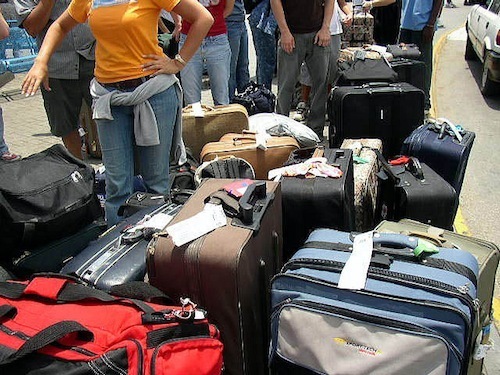
Without fully realizing it, my husband and I had been participating, more than either of us cared to admit, in the consumerist culture we didn’t endorse. I have come to think that there is no way to completely avoid consumerism when the entire culture around you embraces it. Convenience becomes an easy thing to pay for and, before you know it, you have lots of stuff and lots of waste. There are some tough souls who are able to resist this culture to a very impressive level, no matter their surroundings. We put in a strong effort, but when we really looked at the evidence we had to admit that we just didn’t do as well as we had thought.
Long-term travel is an amazing educator when it comes to sustainability. Cars from the 50′s troll the streets of Mumbai, serviced and repaired beyond what any American would think is “reasonable”. Cobblers make a decent living on streets around the world where throwing out shoes with small holes is inconceivable. Chicken wire is taken down and repurposed over and over again until it finds a home within the walls of a cob house in Guatemala. Baby food jars become perfect containers for homemade salves, creams, and cosmetics in Puerto Viejo. Most of the world survives easily without a constant need for new things.
The initial purge is just phase one in a long journey to recognizing the reality of our personal roles in a consumerist society. The continuing journey can be eye opening in terms of illuminating just how much “need” (I use the term loosely) we really could eliminate just by shifting our thinking away from a mentality based in scarcity and replacing it with one based in abundance.
I no longer by things “just in case”. In fact, we no longer buy anything without checking first to see if we can make it, borrow it, or Macgyver it. I still carry a little but of guilt about how much I use to have (and waste) but then again, once you know better, you do better.
What do you think? Has travel influenced your perception of consumerism or changed how you view your consumption habits?
Original article can be found here: Long-term travel, consumerism, and purging
October 14, 2014
Vagabonding Case Study: Lyndsay Cabildo
Vagablogging :: Rolf Potts Vagabonding Blog
Lyndsay Cabildo
Age: 31
Hometown: Manila, Philippines
Quote: “I may be young at age but older in hours, because I wasted no time.” –J. Beacon
How did you find out about Vagabonding, and how did you find it useful before and during the trip?
I’ve seen it online and used some of the site’s helpful travel tips back then.
How long were you on the road?
I am not constantly on the road until 2 years ago. I started building my dreams of traveling the world since I was a kid and realized it in 2004.
Where did you go?
When I left Philippines in 2004, it was for work on board a cruise ship travelling Mediterranean seas and countries. We cruised from Israel, Turkey, Malta, Cyprus, Spain, Greece, Italy, France, and Monaco at the time. After few months working on the ship, I left to work in Italy for 3 years, unfortunately I did not travel Italy then. In 2007, I came back in the Philippines and earned some units in MA in Clinical Psychology.
In 2008, I went for a supposed to be 1 week vacation in Bangkok and met an Australian backpacker, we then traveled together for 1.5 years around Southeast Asia (Thailand, Laos, Vietnam, and Australia), when we broke up I came back in the Philippines and worked in a call center. Few months later, my family and I traveled to Singapore for a holiday. I’ve met old friends and classmates working there and they encouraged me to do the same.
Three months later, I went to Singapore and worked as a Receptionist in a prestigious internationally acclaimed salon for 3 months, when my work permit was denied, I started my backpacking Vietnam and Thailand on my own. I’ve met people who were trying to convince me to work and teach English in Vietnam, but instead I volunteered (in exchange of free accommodation) because I wasn’t ready to commit long term and to get a taste of how is it like teaching and doing it in a different country. I traveled around Vietnam and went back to Philippines, trying to figure out what I really want to do, I worked in a call center, traveled my own country for a bit, saved, and flash pack Malaysia, Brunei, Indonesia. Routine and some personal relationship pushed me to resign. I told myself, I am ready for a long-term backpacking on my own.
I took a TEFL course as my first ticket around the world. Thailand was my first stop. 4 Days later, I got a job as an English Camp teacher (great for travelers, since we get to different places around Thailand, all expense paid, plus daily pay for only few days a week). That’s where I met my fiancé, and we’ve taught at the same group since then and schools. I just resigned as an Academic Manager of a language center where my fiancé taught as well because of the upcoming Eurotrip to meet his parents.
What was your job or source of travel funding for this journey?
I always work in between, save, and then travel. Like I was a cabin stewardess/bar attendant on a cruise ship traveling Mediterranean. The first backpacking with my ex was from my saving from Italy (for working 3 years and sending family money back, I saved some), then I worked as a receptionist in a salon in SG, then volunteered in exchange of accommodation, worked in a call center to save travel funds, and the most recent was teaching English.
Did you work or volunteer on the road?
Yes, I think I detailed it above.
Of all the places you visited, which was your favorite?
I don’t play favorites anymore, because one place has totally different beauty than the other. They are all beautiful in different aspects and level. Like, Santorini was my favorite; Then Krabi was awesome for beaches and sunsets; Then there’s awesome time traveling kind of experience and amazing people in Myanmar; There’s also wonderful food, culture, architecture, and people in Italy; and active and mystic Bali.
Was there a place that was your least favorite, or most disappointing, or most challenging?
Hmmm, I thought I hated Laos because of challenging land travels but when I came back they have progressed a lot! I guess, Hanoi just because they were so intense there and my leg was burned badly by motorbike’s muffler and I didn’t get an apology! You know how Vietnamese city roads are, and if you don’t, try Youtube.
Which travel gear proved most useful? Least useful?
Passport, backpack, and an android were my most used travel necessities. Lonely planet books, because they’re expensive, heavy, and it will never be as accurate as some expects it to be (not that I had one my own).
What are the rewards of the vagabonding lifestyle?
Are you serious? I found my home! (referring to my fiancé- forgive me if I’m cheesy!)
What are the challenges and sacrifices of the vagabonding lifestyle?
I guess when I was starting, as a ‘fashionista’, it was hard to try and live with just whatever can fit in my backpack. You can imagine, how much it changed me.
What lessons did you learn on the road?
It taught me to live simple and you know what? Living simply actually made me happier. It also taught me how to socialize, coming from a very protective family, I didn’t really know how to socialize especially with guys (studied all my life in a prestigious all girls catholic school from grade school to college). I found out it makes you happy to have good friends. Plus, I realized that the less people have, the more they give.
How did your personal definition of “vagabonding” develop over the course of the trip?
It developed by changing the purpose of my travels now. I used to travel to see the world, and then it became to find me, then finding home. Now, it’s giving back in simple little things, of practicing what I’ve learned and still learning what I don’t.
If there was one thing you could have told yourself before the trip, what would it be?
I should have done it earlier.
Any advice or tips for someone hoping to embark on a similar adventure?
Do it early, do it when you’re still young. Do not forget to bring your common sense and values everywhere you go, you are not worth more than any race or person you will meet on the road. RESPECT.
When and where do you think you’ll take your next long-term journey?
I stopped planning, because the journey got me to unbelievably great places and experience since then. Right now, I’m heading to an unknown world I never thought I will be. HOME.
Read more about Lyndsay on her blog, Discount Travel Blogger , or follow him on Facebook and Twitter.
Website: Discount Travel Blogger
Twitter: @LyndsayCabildo
Are you a Vagabonding reader planning, in the middle of, or returning from a journey? Would you like your travel blog or website to be featured on Vagabonding Case Studies? If so, drop us a line at casestudies@vagabonding.net and tell us a little about yourself.
Original article can be found here: Vagabonding Case Study: Lyndsay Cabildo
Rolf Potts's Blog
- Rolf Potts's profile
- 323 followers



